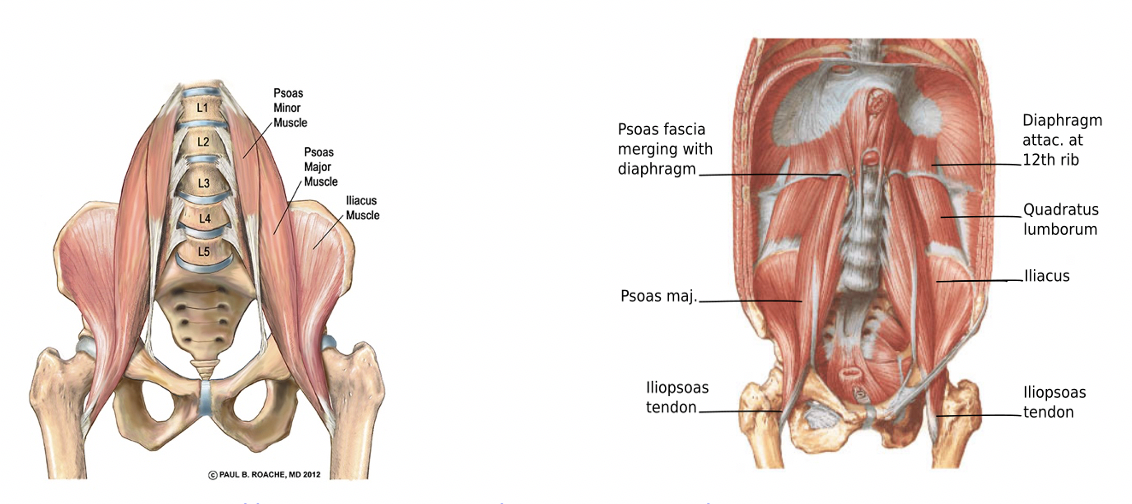Our monkey muscles – the juicy Psoas
Featured in Natural Parent Magazine, Article 4 of 12 in the Clever body series.
The following article exploring the juicy psoas muscles is part four in a series of twelve that will explore some of the main pelvic ligaments and structures that have a role in our reproductive wellbeing. This series of articles will explore the anatomy of the varying structures, discuss how the structures change in response to pregnancy and the postnatal period, discuss how the structures might affect comfort in pregnancy and ease in birth and also investigate and discuss ways to lovingly and gently support these structures so alignment, balance and comfort are optimised.
OH the psoas, so deep, so mysterious.
The psoas (pronounced so-ass) muscles extends on both sides of our bodies from our lumbar vertebrae (L1 to L5), wrapping around the front of our bodies crossing the outer edge of our public bone, it joins with the iliacus muscle at our inguinal ligament and inserts into the lesser trochanter of our femur. The iliacus and psoas together are called the iliopsoas. Sixty five percent of the population have a smaller psoas minor muscle.
The psoas sits deeply in our bodies underneath skin, fat and other muscles – at our core.
It helps wrap our front and our back bodies and our lower half to our upper half. The psoas helps us to stretch sideways and turn. It helps us to walk and have hip flexion. It affects our balance and posture. The psoas muscle has a major role in the position of the pelvis and pelvic stability. The psoas also has an influence on the dynamics of the respiratory diaphragm and also the connection of the respiratory diaphragm and the pelvic floor muscles. Our psoas muscle supports of internal organs so may have a role to play in digestion and constipation. During pregnancy the psoas also supports the baby to find a comfortable position and to descent in labour. There are some bodyworkers like Liz Koch who have spent their lives dedicated to understanding the psoas and its mysterious ways. This link is great if you would like to connect with Liz’s work https://coreawareness.com/
The psoas muscle is in deep relationship with our nervous systems. In particular our startle reflex. When you watch a baby ‘startle’ when they hear a loud sound, it is our primitive mammalian instinct to reach out and grab our monkey mother’s fur so we don’t fall off our monkey mother’s back. As adults we do the same startle reflex if we trip or get a fright. Our psoas muscles constricts to bring us into a foetal position and protect our inner organs. This reflex is driven by a nervous system response and the psoas, without our conscious control, is directly stimulated and responsive. If we stay chronically stressed our psoas muscles can stay chronically contracted. In response the muscle fibres may shorten and instead of behaving like a muscle they can become more dry and less juicy and mobile. It is difficult to consciously let go of the psoas muscles. Particularly if our nervous system continues in an underlying flight or fright reflex (as very commonly happens in response to modern day living). As an embryo the psoas muscles behave like out nervous systems before our nervous systems are developed.
Our darling psoas muscles are super happy when we move in nonlinear ways – bend, stretch and dance. Much of the culture of western living is around sitting for extended periods of time. This can have a shortening effect on the psoas thus affecting our pelvis, abdominal muscles, breathing patterns and head and neck position.
Generally firm massage of the psoas is not recommended but rather self-care and movement may be useful. Some of the psoas stretches involve asymmetrical leg lunges or inversions which may be inappropriate for some pregnant people.
However the psoas responds to delicious resting as demonstrated in the picture below.
Spinning Babies offers some wonderful information and ideas of how to support the psoas based on Liz Koch’s work. Check out this link: https://spinningbabies.com/learn-more/techniques/other-techniques/psoas-muscle-release/
During birth the psoas forms the boundaries in which the baby uses to guide itself out of the womb. The psoas also affects the position and shape of the bony pelvis and also can have an impact on the round ligaments as well (refer to my article in this series on the round ligament).
Someone with a tight psoas in pregnancy may notice that they have pain that’s hard to get to on one side of their middle back. They may also notice lower back pain and constipation. An overly tight psoas can tilt the pelvis more forward leading a to a protruding belly and more likelihood of diastasis recti ( a separation in the abdominal muscles).
To support the psoas to be healthy and comfortable spacious rest is number one. As previously mentioned the condition of the psoas is in direct relationship to the condition of our nervous systems.
Psoas support:
Resting around 45 degrees with the feet together and the knees turned out (as in the picture above)
Dancing
Remaining hydrated
Hip circles and figure 8 movements with the pelvis
Relaxing the inner thighs, like cobblers pose
Deep slow breaths
Spinning Babies® 3 Sister of Balance™
- Reboso manteada
- Forward leaning inversion
- Side lying release
Working gently with our psoas muscles and inviting deep rest into our lives is so crucial when we live in a culture that values productivity and busyness. For pregnancy and birth nurturing our psoas to be soft may assist our abilities to soften, to let go and to release our babes into the world. Caring for our psoas muscles is a way we can deeply support our nervous systems and support ourselves to be settled and responsive rather than reactive.




